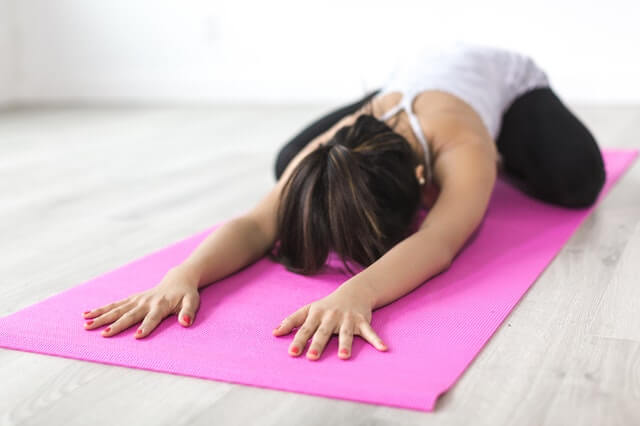You already know that exercise is good for you. Thousands of studies, big and small, have outlined the physical and mental benefits of moving the body to increase the heart rate and burn calories.
For example, regular physical activity can protect you against countless health conditions, like anxiety and depression, type 2 diabetes, stroke, heart disease, and many types of cancer. At least 150 minutes a week of moderate exercise, or 75 minutes per week of vigorous physical activity, can also help you feel more energized, sleep better, and even boost your sex life. That is unless you suffer from exercise-induced migraines.
Does exercising trigger migraines?
Although we are well aware of the health benefits of exercising regularly, it’s not always sunshine and rainbows when you are a migraine sufferer trying to live a healthy, active lifestyle. Unfortunately, exercise can trigger migraines and headaches in some people, especially vigorous or high-intensity activities.
There are at least a couple of theories on what causes exercise-induced headaches. One is that intense physical activity dilates blood vessels in the brain, triggering an inflammatory response that can translate into headaches for those with over-excitable pain receptors. Another possibility is that other triggers, such as light and sound sensitivity, hot weather, and dehydration – and not the act of exercising itself – may play a bigger role in exercise migraines than we thought.
Some research studies have looked into the relationship between exercise and migraines with varying results. An analysis looking at the prevalence of exercise-induced migraines among 1207 headache patients found that physical activity was a triggering factor for 22.1 percent of the participants. A smaller study conducted among 129 New Zealand students suggested that 9 percent suffered from headaches after a vigorous workout.
How exercise may help migraines
While some migraine-prone individuals may experience headaches during or after a workout, regular exercise can, ironically, also reduce the frequency and severity of headaches and migraines. That is one of the reasons why people call exercising “nature’s painkiller.” When you are physically active, your body releases endorphins.
Endorphins are the ‘feel-good’ chemicals responsible for that pleasurable sensation you feel after doing something you quite enjoy, like eating a decadent piece of chocolate cake or have a good belly laugh. They are also behind for that pleasantly relaxed feeling you get after working out or the so-called “runner’s high” that keeps you going long after your legs are singing a different tune.
Endorphins act on opiate receptors in your brain to boost pleasure and reduce pain signals. Some studies have even shown that regular exercise and relaxation techniques such as mindfulness meditation can reduce the frequency of migraines just as effectively as topiramate, a prescription medication used to prevent them.
How often should you exercise if you are a migraine or headache sufferer?
According to the Centers for Disease Control and Prevention (CDC), adults should do 150 minutes of moderate-intensity aerobic exercise (eg, walking) and 2 or more days a week of muscle-strengthening exercises such as light weight lifting each week. It is especially important to work in flexibility exercises into your routine as well.
If you start to feel a migraine or headache coming on… stop exercising! Some good exercises for migraine sufferers include:
Yoga
Research shows that people who do yoga as an add-on migraine therapy have fewer and sometimes less intense headaches. A research study published recently in the peer-reviewed journal Neurology with 160 participants found that doing yoga yielded a significant reduction in headaches frequency, duration, and intensity.

Try yoga
Tai Chi
An ancient mind-body practice often described as “meditation in motion,” tai chi is a gentle, low-impact form of exercise that has been shown to improve flexibility, strength, and balance, which are important if you experience vestibular symptoms. A randomized controlled trial published in the Evidence-Based Complementary and Alternative Medicine Journal showed significant positive health effects after 15 weeks of bi-weekly, hour-long tai chi sessions, including reducing the prevalence of headaches.
Walking
Walking is probably one of the most underrated exercises, but research shows that doing something so simple as just placing one foot in front of the other can be just as good a workout – if not better – than running and other more intense forms of exercise. While running, swimming and cycling are more physically demanding, walking is just as effective for improving your cardiovascular health, burning calories, and improving circulation.
If you are prone to exercise-induced headaches but still want to get your daily dose of sweat, walking is a great option. A good start is to take a short 10 to 15-minute walk every day and gradually increase the pace and duration, always paying attention to and avoiding any potential triggers. The most important thing is to make sure you listen to your body and avoid overexerting yourself, as that can also trigger a migraine.
Also, when working out, always make sure to:
- Avoid exercising in hot, humid environments
- Always warm-up and cool down
- Stay hydrated
Proper warm-up and cool-down
Warm-up for 10 minutes: Warming up prepares your body for exercising and gradually revs up your cardiovascular system by raising your body temperature and increasing blood flow to your muscles. Warming up may also help reduce muscle soreness and lessen your risk of injury. Light stretching before exercising will also loosen your muscles and tendons. This will increase flexibility and range of motion during your workout.
Cool-down for 10 minutes: A sudden stop in physical activity can cause blood pooling in your legs, your blood pressure could drop and you could get very dizzy. The point of cooling down is to give your heart rate the opportunity to get back to its normal rate. Cooling down can minimize the risk of feeling dizzy or faint and can help to prevent muscle soreness. You can do this by walking at a moderate pace. Be sure to also stretch immediately following a workout as part of your cool-down routine.
Every time you move you’re expending water from your body. After an intense workout, you need to replenish water supplies—this helps decrease muscle soreness and increase strength and flexibility.
Exercise is an important part of living a full, healthy life. If you suffer migraine or other conditions, you may want to discuss starting an exercise routine with your physician.


